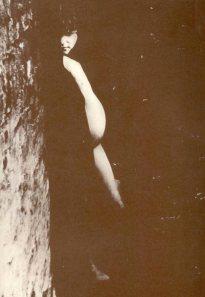If that preacher man wants me to repent, he better pay me more money. – Minnie Rae Simpson
One of the recurring themes of these harlotographies is the difficulty of ascertaining the truth of almost any given detail about the life of any given whore who lived prior to the 20th-century advent of obsessive recordkeeping. The farther back in history one delves, the harder it is to be sure of dates and other details, and the more biography merges into fiction, legend or even myth. By the late 19th century we can be reasonably certain of things like birthdates and residences for whores of middle or upper-class birth, but solid facts about those of the working class – especially in the frontier regions of the young United States – can be just as obscure as those of a person born centuries earlier. Add claims made by the lady herself to entice customers or inflate her reputation, and those made by reporters, biographers and other tall-tale-tellers during her life and after her death, and we have the recipe for a legend as misty as that of King Arthur even if its subject lived well into recent times.
One excellent example of this is the story of Minnie Rae (sometimes called Mary) Simpson, a young San Francisco streetwalker of the 1870s. According to the popular narrative of her life, she was born in or near Philadelphia in 1860 to a woman known only as Lacey; her father is said to have been a shoe worker who participated in the Great New England Shoemakers’ Strike which began on February 22nd, 1860. He is supposed to have died en route to California in 1862, either just before or just after the birth of Minnie’s younger brother, Adam. Lacey claimed a land grant near San Francisco under the Homestead Act and managed to build up a small farm, relying on young Minnie for assistance with her baby brother; however, she died of scarlet fever in 1869, leaving the girl an orphan (it is unknown whether Adam survived). Without family or even friends in the area, Minnie was forced to provide for herself and did so, as so many others have throughout history, by prostitution; she lived for a time with a Mr. Simpson (from whom she took her surname) and is supposed to have traveled with him the following year to England and Scotland. There she is said to have met the young J.M. Barrie, who in later years wrote Peter Pan and patterned the character of Wendy after her.
 While on this tour she became pregnant, and the only known photograph of her was taken in 1871. She gave birth to a son (whom she named Bartholomew) the following year; by this point she was no longer with Simpson and lived mostly on the street. She was a close friend to the notable San Francisco eccentric Emperor Norton, who proclaimed her “The Little Countess”, and the association almost certainly contributed heavily to her fame; during the same time period she gave a series of interviews to a journalist, who turned them into a book entitled My Life as a Child Prostitute: The Autobiography of Minnie Rae. Given the subject matter, it seems likely that the reason the journalist remained anonymous was to avoid controversy or even accusations of being one of Minnie’s clients. It was a wise precaution; though the Cult of the Child was not yet in full swing in the US, Minnie’s pragmatic view of prostitution (“I get paid to be a whore. If I married some farmer, I’d have to do it for free”) and her statements that prostitutes do the work because it’s lucrative and gives them a high degree of freedom, were almost as incendiary then as they would be now. Only a few copies were ever printed, and these were gathered together by a preacher and burned in 1880, soon after the Emperor Norton’s death. One copy survived, and was passed down to her descendants by Bartholomew until it, too was lost sometime in the late 20th century; only a few photocopied pages remain. Minnie herself left San Francisco in 1873 and vanished from history; how Bartholomew knew anything about his mother or gained his copy of her book is entirely unclear, considering he was an infant at the time. The only other concrete evidence of her existence is Minna Street in San Francisco, named for her by a politician who was one of her clients.
While on this tour she became pregnant, and the only known photograph of her was taken in 1871. She gave birth to a son (whom she named Bartholomew) the following year; by this point she was no longer with Simpson and lived mostly on the street. She was a close friend to the notable San Francisco eccentric Emperor Norton, who proclaimed her “The Little Countess”, and the association almost certainly contributed heavily to her fame; during the same time period she gave a series of interviews to a journalist, who turned them into a book entitled My Life as a Child Prostitute: The Autobiography of Minnie Rae. Given the subject matter, it seems likely that the reason the journalist remained anonymous was to avoid controversy or even accusations of being one of Minnie’s clients. It was a wise precaution; though the Cult of the Child was not yet in full swing in the US, Minnie’s pragmatic view of prostitution (“I get paid to be a whore. If I married some farmer, I’d have to do it for free”) and her statements that prostitutes do the work because it’s lucrative and gives them a high degree of freedom, were almost as incendiary then as they would be now. Only a few copies were ever printed, and these were gathered together by a preacher and burned in 1880, soon after the Emperor Norton’s death. One copy survived, and was passed down to her descendants by Bartholomew until it, too was lost sometime in the late 20th century; only a few photocopied pages remain. Minnie herself left San Francisco in 1873 and vanished from history; how Bartholomew knew anything about his mother or gained his copy of her book is entirely unclear, considering he was an infant at the time. The only other concrete evidence of her existence is Minna Street in San Francisco, named for her by a politician who was one of her clients.
Now, the skeptical reader will no doubt already see a few problems with this narrative; though there are exceptions to every rule, in the late 19th century the average age of menarche in the US was about 14, and conditions such as Minnie lived in would tend to raise the age due to poor nutrition; in other words, getting pregnant at the age of 11 was even less likely in 1871 than it is now, and delivering a healthy baby from such a pregnancy would be unlikelier still. Furthermore, though she was undoubtedly precocious, her making the kind of splash that she did in the short time she managed it seems to me less like something a 10 or 11-year-old could accomplish, and more like the actions of a bright 14 or 15-year-old with a baby face who realized that lurid narratives sell. The intelligent, outgoing Minnie was well-known among clients and acquaintances as a tale-teller, and she even boasted that Mark Twain had been inspired by some of her yarns; it seems very likely that she ratcheted her age down a few years for the sake of marketing, but whether she told her clients that age or whether it was something she came up with for a credulous journalist is unknown. Given that her business is known to have gone up after she got pregnant (an obvious sign of more advanced physical maturity), and that underage whores still to this day exaggerate their back-stories for gullible members of the press, the latter seems far more likely. One thing I find fascinating is that those who retell her story never find it odd that her birth year is known with such certainty despite the fact that her birthplace, her original surname and any event of her life after 1873 are not; I reckon the wanking fantasy of the pregnant 10-year-old streetwalker is just too juicy to pass up.
 Larger-than-life characters tend to live on in the imaginations of others long after their deaths, and Minnie Rae is no exception. Beside Peter Pan’s Wendy, she was also named a Discordian saint in 2006 (unsurprising, given that the Emperor Norton was a major influence on the philosophy); the Discordians seem to have started a rumor that the BART (Bay Area Rapid Transit) train system was named after her son Bartholomew. Minnie believed in reincarnation, and claimed to have been a Babylonian harlot who was mentioned in the Bible; whether she meant Revelation’s “Whore of Babylon” is unknown. But it seems likely that her belief inspired two modern-day strippers to claim to be Minnie reincarnated; one of them, who went by Fannie Mae, worked in Los Angeles during the ‘90’s. The other, Kitty, worked on Bourbon Street in New Orleans during the ‘50s and ‘60s, knew Lord Omar Khayyam Ravenhurst (one of the founders of Discordianism), and because of that connection (and a tentative one to Jack Ruby) was suspected by Jim Garrison as being connected to the Kennedy assassination conspiracy. Confused yet? Read some of the links, and it’ll probably get worse. But it all goes to show that when dealing with the demimonde, appearances are often more important than reality, and adhering to conventional beliefs about women and girls is foolish at best.
Larger-than-life characters tend to live on in the imaginations of others long after their deaths, and Minnie Rae is no exception. Beside Peter Pan’s Wendy, she was also named a Discordian saint in 2006 (unsurprising, given that the Emperor Norton was a major influence on the philosophy); the Discordians seem to have started a rumor that the BART (Bay Area Rapid Transit) train system was named after her son Bartholomew. Minnie believed in reincarnation, and claimed to have been a Babylonian harlot who was mentioned in the Bible; whether she meant Revelation’s “Whore of Babylon” is unknown. But it seems likely that her belief inspired two modern-day strippers to claim to be Minnie reincarnated; one of them, who went by Fannie Mae, worked in Los Angeles during the ‘90’s. The other, Kitty, worked on Bourbon Street in New Orleans during the ‘50s and ‘60s, knew Lord Omar Khayyam Ravenhurst (one of the founders of Discordianism), and because of that connection (and a tentative one to Jack Ruby) was suspected by Jim Garrison as being connected to the Kennedy assassination conspiracy. Confused yet? Read some of the links, and it’ll probably get worse. But it all goes to show that when dealing with the demimonde, appearances are often more important than reality, and adhering to conventional beliefs about women and girls is foolish at best.
